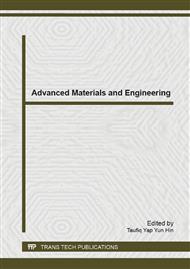[1]
Z. H. Yu, L. Liu, X. B. Zhao. Effect of solidification rate on MC carbide morphology in single crystal Ni-base superalloy AM3. Transactions of Nonferrous Metals Society of China. 2010, 20(10):1835-1840.
DOI: 10.1016/s1003-6326(09)60382-4
Google Scholar
[1]
Mihalisin, J R. Some Effects of Carbon in the Production of Single Crystal Superalloy Castings. Superalloys, TMS. 2004: 795-799.
DOI: 10.7449/2004/superalloys_2004_795_800
Google Scholar
[3]
Z. H. Yu, L. Liu, X. B. Zhao. Effect of carbon additions on the microstructure of a single crystal Ni-base superalloy AM3. China Foundry. 2010, 7(4):352-356.
Google Scholar
[4]
K.A. Al-Jarba and G.E. Fuchs, Effect of Carbon Additions on the As-Cast Microstructure and Defect Formation of a Single Crystal Ni-Based Superalloy, Mat. Sci. and Eng. A, 373 (2004), 255-267.
DOI: 10.1016/j.msea.2004.01.030
Google Scholar
[5]
K A. Al-Garba. Effect of Carbon Additions on the Microstructure and the Mechanical Properties of Model Single Crystal Ni-base Superalloy, Ph. D. Thesis, 2003, University of Florida: 12-14.
Google Scholar
[6]
S. Tin, P. D. Lee, A. Kermanpur. Integrated modeling for the manufacture of Ni-based superalloy discs from solidification to final heat treatment. Metallurgical and materials transactions. 36A, 9, (2005): 2493-2504.
DOI: 10.1007/s11661-005-0123-2
Google Scholar
[7]
E.C. Caldwell, F.J. Fela, G.E. Fuchs. Segregation of Elements in High Refractory Content Single Crystal Nickel Based Superalloys. K.A. Green, T.M. Pollock, H. Harada, et al. Superalloys 2004, Pennsylvania, 2004. Warrendale, PA, TMS, 2004: 811-818.
DOI: 10.7449/2004/superalloys_2004_811_818
Google Scholar
[8]
E.C. Caldwell, F.J. Fela, G.E. Fuchs. The Segregation of Elements in High Refractory Content Single Crystal Nickei-based Superalloys. Journal of the Minerals, Metals and Materials Society. 2004, 56(9): 44-48.
DOI: 10.1007/s11837-004-0200-9
Google Scholar
[9]
Gang Liu, Lin Liu, Cheng Ai. Influence of withdrawal rates on the microstructures of Ni-base single-crystal superalloys containing Re and Ru. Jounal of Alloy and Compounds. 2011, 509(19): 5866-5872.
DOI: 10.1016/j.jallcom.2011.02.156
Google Scholar
[10]
Gang Liu, Lin Liu, Xinbao Zhao. Effects of Re and Ru on the solidification characteristics of nickel-base single-crystal superalloys. Metallurgical and Materials Transactions A. 2011, 42A: 2733-2741.
DOI: 10.1007/s11661-011-0673-4
Google Scholar
[11]
E. C. Caldwell, F. J. Fela, G. E. Fuchs. Segregation of Elements in High Refractory Content Single Crystal Nickel Based Superalloys. Superalloys 2004. The Minerals, Metals & Materials Society. 2004: 801-810.
DOI: 10.7449/2004/superalloys_2004_811_818
Google Scholar
[12]
R.M. Kearsey, J.C. Beddoes, K.M. Jaansalu, W.T. Thompson, P. Au1. The Effects of Re, W and Ru on Microsegregation Behavior in Single Crystal Superalloy Systems, Superalloys 2004, TMS, 2004: 801-810.
DOI: 10.7449/2004/superalloys_2004_801_810
Google Scholar
[13]
R.A. Hobbs, L. Zhang, C.M.F. Rae, S. Tin. The effects of ruthenium on the intermediate to high temperature creep response of high refractory content single crystal nickel-base superalloys. Mater. Sci. Eng. A. 2008, 489: 65-76.
DOI: 10.1016/j.msea.2007.12.045
Google Scholar
[14]
A. Mottura, N. Warnken, M.K. Miller, M.W. Finnis. R.C. Reed. Atom probe tomography analysis of the distribution of rhenium in nickel alloys. Acta Mater. 2010, 58(3): 931-942.
DOI: 10.1016/j.actamat.2009.10.008
Google Scholar
[15]
B.H. Ge, Y.S. Luo, J.R. Li, J. Zhu. Distribution of rhenium in a single crystal nickel-based superalloy. Scripta Mater. 2010, 63: 969-972.
DOI: 10.1016/j.scriptamat.2010.07.019
Google Scholar
[16]
L.R. Liu, T. Jin, N.R. Zhao. Effect of Carbon Additions on the Microstructure in a Ni-base Single Crystal Superalloy. Materials Letters. 2004, 58: 2290-2294.
DOI: 10.1016/j.matlet.2004.01.038
Google Scholar


